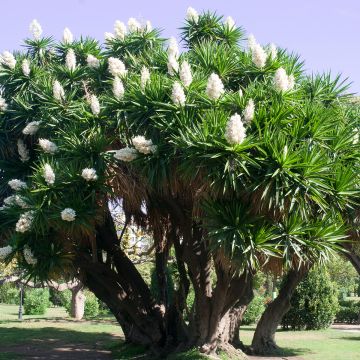

Yucca gloriosa Citrus Twist
Yucca gloriosa Citrus Twist
Yucca gloriosa Citrus twist®
Spanish Dagger, Adam's needle, Lord's candlestick, Glorious Yucca
Special offer!
Receive a €20 voucher for any order over €90 (excluding delivery costs, credit notes, and plastic-free options)!
1- Add your favorite plants to your cart.
2- Once you have reached €90, confirm your order (you can even choose the delivery date!).
3- As soon as your order is shipped, you will receive an email containing your voucher code, valid for 3 months (90 days).
Your voucher is unique and can only be used once, for any order with a minimum value of €20, excluding delivery costs.
Can be combined with other current offers, non-divisible and non-refundable.
Home or relay delivery (depending on size and destination)
Schedule delivery date,
and select date in basket
This plant carries a 24 months recovery warranty
More information
We guarantee the quality of our plants for a full growing cycle, and will replace at our expense any plant that fails to recover under normal climatic and planting conditions.
Would this plant suit my garden?
Set up your Plantfit profile →
Description
Yucca gloriosa Citrus Twist, with its evergreen foliage that is almost multicoloured and its succulent plant appearance, allows every gardener to add a beautiful exotic touch to their garden or balcony. This unusual variety indeed develops foliage which is randomly variegated with different shades of yellow and green, with the border becoming more or less orange to red over time under the effect of the sun. The plant possesses the same qualities of resistance, sparing use of water, and hardiness as the type species. Its long, tough, and pointed leaves are gathered in a rosette from which a spectacular flowering stalk emerges in summer, adorned with numerous flowers resembling large white bells. Discover it today!
Originally from the southeastern United States, growing along the coast and in dune areas, Yucca gloriosa has naturalised in many countries. It is a rhizomatous plant belonging to the agave family. The Citrus Twist cultivar stands out with its remarkably coloured leaves, which are slightly longer and more flexible. When young, Yucca gloriosa Citrus Twist forms a somewhat untidy and naturally unbranched ball. After many years, it can form a very short trunk, ramified into several branches. In our temperate climates, the plant will reach about 1.5 m (5 ft) in height when flowering, and 1 m (3 ft) for the foliage. The wide, thick and gutter-shaped leaves are about 80 cm (32 in) long, 6 cm (2 in) wide and lanceolate, with a hard and very pointed tip. Flowering occurs after 3 to 4 years of growth and signals the death of the rosette which will then be replaced by another one. Very fragrant and nectar-rich, the flowers resemble bell-shaped blooms. They are white to off-white in colour, sometimes washed with wine lees, and their reverse side is stained with deep pink. The flower buds display different shades of deep pink. They are carried on upright and branched panicles, which are very decorative.
Yucca gloriosa Citrus Twist is hardy below -15 °C (5 °F) and very easy to grow. It will thrive in any well-drained or even dry and poor soil. It should be kept away from paths and young children due to its sharp-pointed leaves. This large, bright, and variegated plant is ideal for structuring a large rock garden or for brilliantly occupying the centre of an exotic flower bed. It can be planted alone or combined with Puya, Agave americana, Dasylirion, and fairly hardy prickly pear cacti that appreciate the same growing conditions, on a dry slope. It can also be placed in a very large pot on the terrace, where it truly catches the eye.
Report an error about the product description
Yucca gloriosa Citrus Twist in pictures


Plant habit
Flowering
Foliage
Botanical data
Yucca
gloriosa
Citrus twist®
Agavaeae
Spanish Dagger, Adam's needle, Lord's candlestick, Glorious Yucca
Cultivar or hybrid
Other Yucca
View all →Planting and care
Plant Yucca gloriosa Citrus Twist in a very sunny location and in well-drained, ordinary soil, or even sandy, poor, rocky and limestone soil. Remove dead stems.
Planting period
Intended location
Care
This item has not been reviewed yet - be the first to leave a review about it.
Similar products
Haven't found what you were looking for?
Hardiness is the lowest winter temperature a plant can endure without suffering serious damage or even dying. However, hardiness is affected by location (a sheltered area, such as a patio), protection (winter cover) and soil type (hardiness is improved by well-drained soil).

Photo Sharing Terms & Conditions
In order to encourage gardeners to interact and share their experiences, Promesse de fleurs offers various media enabling content to be uploaded onto its Site - in particular via the ‘Photo sharing’ module.
The User agrees to refrain from:
- Posting any content that is illegal, prejudicial, insulting, racist, inciteful to hatred, revisionist, contrary to public decency, that infringes on privacy or on the privacy rights of third parties, in particular the publicity rights of persons and goods, intellectual property rights, or the right to privacy.
- Submitting content on behalf of a third party;
- Impersonate the identity of a third party and/or publish any personal information about a third party;
In general, the User undertakes to refrain from any unethical behaviour.
All Content (in particular text, comments, files, images, photos, videos, creative works, etc.), which may be subject to property or intellectual property rights, image or other private rights, shall remain the property of the User, subject to the limited rights granted by the terms of the licence granted by Promesse de fleurs as stated below. Users are at liberty to publish or not to publish such Content on the Site, notably via the ‘Photo Sharing’ facility, and accept that this Content shall be made public and freely accessible, notably on the Internet.
Users further acknowledge, undertake to have ,and guarantee that they hold all necessary rights and permissions to publish such material on the Site, in particular with regard to the legislation in force pertaining to any privacy, property, intellectual property, image, or contractual rights, or rights of any other nature. By publishing such Content on the Site, Users acknowledge accepting full liability as publishers of the Content within the meaning of the law, and grant Promesse de fleurs, free of charge, an inclusive, worldwide licence for the said Content for the entire duration of its publication, including all reproduction, representation, up/downloading, displaying, performing, transmission, and storage rights.
Users also grant permission for their name to be linked to the Content and accept that this link may not always be made available.
By engaging in posting material, Users consent to their Content becoming automatically accessible on the Internet, in particular on other sites and/or blogs and/or web pages of the Promesse de fleurs site, including in particular social pages and the Promesse de fleurs catalogue.
Users may secure the removal of entrusted content free of charge by issuing a simple request via our contact form.
The flowering period indicated on our website applies to countries and regions located in USDA zone 8 (France, the United Kingdom, Ireland, the Netherlands, etc.)
It will vary according to where you live:
- In zones 9 to 10 (Italy, Spain, Greece, etc.), flowering will occur about 2 to 4 weeks earlier.
- In zones 6 to 7 (Germany, Poland, Slovenia, and lower mountainous regions), flowering will be delayed by 2 to 3 weeks.
- In zone 5 (Central Europe, Scandinavia), blooming will be delayed by 3 to 5 weeks.
In temperate climates, pruning of spring-flowering shrubs (forsythia, spireas, etc.) should be done just after flowering.
Pruning of summer-flowering shrubs (Indian Lilac, Perovskia, etc.) can be done in winter or spring.
In cold regions as well as with frost-sensitive plants, avoid pruning too early when severe frosts may still occur.
The planting period indicated on our website applies to countries and regions located in USDA zone 8 (France, United Kingdom, Ireland, Netherlands).
It will vary according to where you live:
- In Mediterranean zones (Marseille, Madrid, Milan, etc.), autumn and winter are the best planting periods.
- In continental zones (Strasbourg, Munich, Vienna, etc.), delay planting by 2 to 3 weeks in spring and bring it forward by 2 to 4 weeks in autumn.
- In mountainous regions (the Alps, Pyrenees, Carpathians, etc.), it is best to plant in late spring (May-June) or late summer (August-September).
The harvesting period indicated on our website applies to countries and regions in USDA zone 8 (France, England, Ireland, the Netherlands).
In colder areas (Scandinavia, Poland, Austria...) fruit and vegetable harvests are likely to be delayed by 3-4 weeks.
In warmer areas (Italy, Spain, Greece, etc.), harvesting will probably take place earlier, depending on weather conditions.
The sowing periods indicated on our website apply to countries and regions within USDA Zone 8 (France, UK, Ireland, Netherlands).
In colder areas (Scandinavia, Poland, Austria...), delay any outdoor sowing by 3-4 weeks, or sow under glass.
In warmer climes (Italy, Spain, Greece, etc.), bring outdoor sowing forward by a few weeks.


















































